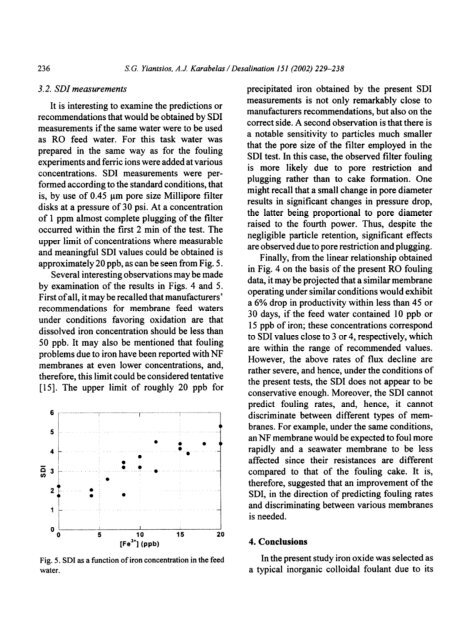An assessment of the Silt Density Index based on RO membrane ...
An assessment of the Silt Density Index based on RO membrane ...
An assessment of the Silt Density Index based on RO membrane ...
Create successful ePaper yourself
Turn your PDF publications into a flip-book with our unique Google optimized e-Paper software.
236 S.G. Yiantsios, A. J. Karabelas /Desalinati<strong>on</strong> 151 (2002) 229-238<br />
3.2. SDI measurements<br />
It is interesting to examine <str<strong>on</strong>g>the</str<strong>on</strong>g> predicti<strong>on</strong>s or<br />
recommendati<strong>on</strong>s that would be obtained by SD1<br />
measurements if <str<strong>on</strong>g>the</str<strong>on</strong>g> same water were to be used<br />
as <strong>RO</strong> feed water. For this task water was<br />
prepared in <str<strong>on</strong>g>the</str<strong>on</strong>g> same way as for <str<strong>on</strong>g>the</str<strong>on</strong>g> fouling<br />
experiments and ferric i<strong>on</strong>s were added at various<br />
c<strong>on</strong>centrati<strong>on</strong>s. SD1 measurements were performed<br />
according to <str<strong>on</strong>g>the</str<strong>on</strong>g> standard c<strong>on</strong>diti<strong>on</strong>s, that<br />
is, by use <str<strong>on</strong>g>of</str<strong>on</strong>g> 0.45 pm pore size Millipore filter<br />
disks at a pressure <str<strong>on</strong>g>of</str<strong>on</strong>g> 30 psi. At a c<strong>on</strong>centrati<strong>on</strong><br />
<str<strong>on</strong>g>of</str<strong>on</strong>g> 1 ppm almost complete plugging <str<strong>on</strong>g>of</str<strong>on</strong>g> <str<strong>on</strong>g>the</str<strong>on</strong>g> filter<br />
occurred within <str<strong>on</strong>g>the</str<strong>on</strong>g> first 2 min <str<strong>on</strong>g>of</str<strong>on</strong>g> <str<strong>on</strong>g>the</str<strong>on</strong>g> test. The<br />
upper limit <str<strong>on</strong>g>of</str<strong>on</strong>g> c<strong>on</strong>centrati<strong>on</strong>s where measurable<br />
and meaningful SD1 values could be obtained is<br />
approximately 20 ppb, as can be seen from Fig. 5.<br />
Several interesting observati<strong>on</strong>s may be made<br />
by examinati<strong>on</strong> <str<strong>on</strong>g>of</str<strong>on</strong>g> <str<strong>on</strong>g>the</str<strong>on</strong>g> results in Figs. 4 and 5.<br />
First <str<strong>on</strong>g>of</str<strong>on</strong>g> all, it may be recalled that manufacturers’<br />
recommendati<strong>on</strong>s for <strong>membrane</strong> feed waters<br />
under c<strong>on</strong>diti<strong>on</strong>s favoring oxidati<strong>on</strong> are that<br />
dissolved ir<strong>on</strong> c<strong>on</strong>centrati<strong>on</strong> should be less than<br />
50 ppb. It may also be menti<strong>on</strong>ed that fouling<br />
problems due to ir<strong>on</strong> have been reported with NF<br />
<strong>membrane</strong>s at even lower c<strong>on</strong>centrati<strong>on</strong>s, and,<br />
<str<strong>on</strong>g>the</str<strong>on</strong>g>refore, this limit could be c<strong>on</strong>sidered tentative<br />
[ 151. The upper limit <str<strong>on</strong>g>of</str<strong>on</strong>g> roughly 20 ppb for<br />
$3<br />
2<br />
1<br />
.;<br />
+<br />
b<br />
f .<br />
/<br />
c<br />
0 ~~.~_~.~~_..~~~~ _--t..“_-.-__._-.. _-.._I<br />
lFe3’~kW<br />
15 20<br />
Fig. 5. SD1 as a functi<strong>on</strong> <str<strong>on</strong>g>of</str<strong>on</strong>g> ir<strong>on</strong> c<strong>on</strong>centrati<strong>on</strong> in <str<strong>on</strong>g>the</str<strong>on</strong>g> feed<br />
water.<br />
precipitated ir<strong>on</strong> obtained by <str<strong>on</strong>g>the</str<strong>on</strong>g> present SD1<br />
measurements is not <strong>on</strong>ly remarkably close to<br />
manufacturers recommendati<strong>on</strong>s, but also <strong>on</strong> <str<strong>on</strong>g>the</str<strong>on</strong>g><br />
correct side. A sec<strong>on</strong>d observati<strong>on</strong> is that <str<strong>on</strong>g>the</str<strong>on</strong>g>re is<br />
a notable sensitivity to particles much smaller<br />
that <str<strong>on</strong>g>the</str<strong>on</strong>g> pore size <str<strong>on</strong>g>of</str<strong>on</strong>g> <str<strong>on</strong>g>the</str<strong>on</strong>g> filter employed in <str<strong>on</strong>g>the</str<strong>on</strong>g><br />
SD1 test. In this case, <str<strong>on</strong>g>the</str<strong>on</strong>g> observed filter fouling<br />
is more likely due to pore restricti<strong>on</strong> and<br />
plugging ra<str<strong>on</strong>g>the</str<strong>on</strong>g>r than to cake formati<strong>on</strong>. One<br />
might recall that a small change in pore diameter<br />
results in significant changes in pressure drop,<br />
<str<strong>on</strong>g>the</str<strong>on</strong>g> latter being proporti<strong>on</strong>al to pore diameter<br />
raised to <str<strong>on</strong>g>the</str<strong>on</strong>g> fourth power. Thus, despite <str<strong>on</strong>g>the</str<strong>on</strong>g><br />
negligible particle retenti<strong>on</strong>, significant effects<br />
are observed due to pore restricti<strong>on</strong> and plugging.<br />
Finally, from <str<strong>on</strong>g>the</str<strong>on</strong>g> linear relati<strong>on</strong>ship obtained<br />
in Fig. 4 <strong>on</strong> <str<strong>on</strong>g>the</str<strong>on</strong>g> basis <str<strong>on</strong>g>of</str<strong>on</strong>g> <str<strong>on</strong>g>the</str<strong>on</strong>g> present <strong>RO</strong> fouling<br />
data, it may be projected that a similar <strong>membrane</strong><br />
operating under similar c<strong>on</strong>diti<strong>on</strong>s would exhibit<br />
a 6% drop in productivity within less than 45 or<br />
30 days, if <str<strong>on</strong>g>the</str<strong>on</strong>g> feed water c<strong>on</strong>tained 10 ppb or<br />
15 ppb <str<strong>on</strong>g>of</str<strong>on</strong>g> ir<strong>on</strong>; <str<strong>on</strong>g>the</str<strong>on</strong>g>se c<strong>on</strong>centrati<strong>on</strong>s corresp<strong>on</strong>d<br />
to SD1 values close to 3 or 4, respectively, which<br />
are within <str<strong>on</strong>g>the</str<strong>on</strong>g> range <str<strong>on</strong>g>of</str<strong>on</strong>g> recommended values.<br />
However, <str<strong>on</strong>g>the</str<strong>on</strong>g> above rates <str<strong>on</strong>g>of</str<strong>on</strong>g> flux decline are<br />
ra<str<strong>on</strong>g>the</str<strong>on</strong>g>r severe, and hence, under <str<strong>on</strong>g>the</str<strong>on</strong>g> c<strong>on</strong>diti<strong>on</strong>s <str<strong>on</strong>g>of</str<strong>on</strong>g><br />
<str<strong>on</strong>g>the</str<strong>on</strong>g> present tests, <str<strong>on</strong>g>the</str<strong>on</strong>g> SD1 does not appear to be<br />
c<strong>on</strong>servative enough. Moreover, <str<strong>on</strong>g>the</str<strong>on</strong>g> SD1 cannot<br />
predict fouling rates, and, hence, it cannot<br />
discriminate between different types <str<strong>on</strong>g>of</str<strong>on</strong>g> <strong>membrane</strong>s.<br />
For example, under <str<strong>on</strong>g>the</str<strong>on</strong>g> same c<strong>on</strong>diti<strong>on</strong>s,<br />
an NF <strong>membrane</strong> would be expected to foul more<br />
rapidly and a seawater <strong>membrane</strong> to be less<br />
affected since <str<strong>on</strong>g>the</str<strong>on</strong>g>ir resistances are different<br />
compared to that <str<strong>on</strong>g>of</str<strong>on</strong>g> <str<strong>on</strong>g>the</str<strong>on</strong>g> fouling cake. It is,<br />
<str<strong>on</strong>g>the</str<strong>on</strong>g>refore, suggested that an improvement <str<strong>on</strong>g>of</str<strong>on</strong>g> <str<strong>on</strong>g>the</str<strong>on</strong>g><br />
SDI, in <str<strong>on</strong>g>the</str<strong>on</strong>g> directi<strong>on</strong> <str<strong>on</strong>g>of</str<strong>on</strong>g> predicting fouling rates<br />
and discriminating between various <strong>membrane</strong>s<br />
is needed.<br />
4. C<strong>on</strong>clusi<strong>on</strong>s<br />
In <str<strong>on</strong>g>the</str<strong>on</strong>g> present study ir<strong>on</strong> oxide was selected as<br />
a typical inorganic colloidal foulant due to its

















